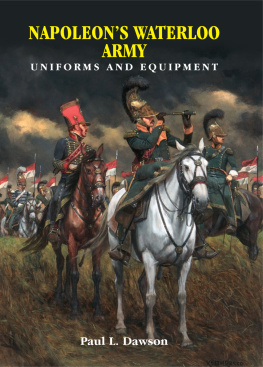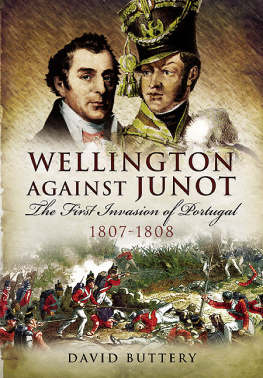
Napoleons Peninsular War
Napoleons Peninsular War
The French Experience of the War in Spain from Vimeiro to Corunna 18081809
Paul L. Dawson
First published in Great Britain in 2020 by
Frontline Books
An imprint of
Pen & Sword Books Ltd
Yorkshire Philadelphia
Copyright Paul L. Dawson, 2020
ISBN 978 1 52675 409 7
eISBN 978 1 52675 410 3
Mobi ISBN 978 1 52675 411 0
The right of Paul L. Dawson to be identified as the author of this work has been asserted by him in accordance with the Copyright, Designs and Patents Act 1988.
A CIP catalogue record for this book is available from the British Library.
All rights reserved. No part of this book may be reproduced or transmitted in any form or by any means, electronic or mechanical including photocopying, recording or by any information storage and retrieval system, without permission from the Publisher in writing.
Typeset in Chennai, India
by Lapiz Digital Services.
Pen & Sword Books Ltd incorporates the Imprints of Aviation, Atlas, Family History, Fiction, Maritime, Military, Discovery, Politics, History, Archaeology, Select, Wharncliffe Local History, Wharncliffe True Crime, Military Classics, Wharncliffe Transport, Leo Cooper, The Praetorian Press, Remember When, Seaforth Publishing and Frontline Publishing.
For a complete list of Pen & Sword titles please contact
PEN & SWORD BOOKS LTD
47 Church Street, Barnsley, South Yorkshire, S70 2AS, England
E-mail:
Website: www.pen-and-sword.co.uk
Or
PEN AND SWORD BOOKS
1950 Lawrence Rd, Havertown, PA 19083, USA
E-mail:
Website: www.penandswordbooks.com
Contents
List of Illustrations
Acknowledgements
Introduction
Chapter 1: The Reasons for War
Chapter 2: War
Chapter 3: Rolia and Vimeiro
Chapter 4: Rio Seco
Chapter 5: Baylen
Chapter 6: Napoleons Response
Chapter 7: The Zornosa Campaign.
Chapter 8: Napoleons Campaign Begins
Chapter 9: Espinosa
Chapter 10: Tudella.
Chapter 11: March to Zaragoza
Chapter 12: Advance to Somosierra
Chapter 13: The Battle of Somosierra
Chapter 14: Entry into Madrid
Chapter 15: Arzobispo
Chapter 16: Action at Tarancon
Chapter 17: Benavente
Chapter 18: Advance to Corua
Chapter 19: Corua Preparations
Chapter 20: The Battle of Corua
Chapter 21: Ucls
Chapter 22: Conclusion
Appendix 1: Somosierra Eyewitnesses
Appendix 2: Corua Eyewitnesses
Notes
Sources
List of Illustrations
Map of the battle of Medina del Rio Seco. One of the most outstanding victories from 1808, in no small part due to Georges Mouton, future Comte Lobau.
The battle of Gamonel was a pivotal moment in the 1808 campaign. Marshals Lannes and Ney were to fight a twin action, to trap and crush the Spanish armies. Ney bungled his operations, and lost the French a tactical victory.
French forces in northern Spain in 31 October 1808, prior to the Emperor taking direct command.
French positions in central Spain on 31 October 1808.
French positions on 3 November 1808 as the two French forces began to separate to head to Burgos and Tudela.
Location of French forces around Burgos on 8 November, with Lasalles cavalry in the vanguard.
The French and Spanish positions at Burgos on 10 November 1808 shortly before Marshal Soult took command.
Marshal Soults positions around Burgos on 12 November 1808 after he had captured the town.
Troop positions of Marshals Victor and Lefebvre at Espinosa on 10 November 1808.
Positions of the armies of Victor and Lefebvre on 12 November 1808.
The opening positions of the French and Spanish forces at Espinosa.
Second positions of the French and Spanish forces at Espinosa, a tactical French victory, but one that was squandered by Marshal Lefebvre acting without orders.
Position of Marshal Monceys forces relative to the Spanish field armies on 8 November 1808
Moncey headed to besiege Zaragoza, the map shows his positions on 10 November 1808.
Marshal Monceys positions at Zaragoza on 12 November 1808 shortly before the siege was to begin in earnest.
Position of French forces around Vitoria on 12 November 1808, shortly before the push against the Spanish towards Madrid began.
The Battle of Zornoza, a tactical French victory.
The Battle of Corua, a tactical victory by the forces of Marshal Soult against the British Army.
The French advance to Corua was conducted through snow and ice as vividly imagined in this painting.
The capitulation of Madrid as pained by Gros. This marked the apogee of the Emperors campaign in Spain, made possible by the brilliant action at Somosierra
Marshal Jourdan, Chief of Staff to King Joseph.
Joseph Bonaparte, King of Spain. A moral coward, his ineptness cost the French outright victory in the Peninsular War on several occasions.
Andoche Junot, the corporal of Toulon, who bungled the invasion of Portugal and lost his army.
Marshal Moncey. Doyen of the active marshals, he openly criticised the Emperor and fellow marshals, which resulted him in being stripped of command and sent back to French.
Marshal Ney, Bravest of the Brave, but a man whose abilities as a field commander were utterly lacking during the 1808 campaign in Spain. He bungled all his orders and refused to co-operate with Soult, Lannes or Moncey, yet was not stripped of command.
Marshal Soult, lead 2nd Corps faultlessly throughout the campaign of 1808 and into 1809. A great administrator and leader of men.
Marshal Bessires; a great cavalry officer but a poor field commander. His timidity resulted in him being stripped of his command.
Marshal Lannes, victor of Tudela, harsh critic of Neys bungling and victor of Saragossa.
General Montbrun, hero of Medina del Rio Seco and Somosierra.
Auguste de Colbert, who got himself uselessly killed in December 1808.
Lefebvre-Desnottes, a man whose judgement was seriously lacking at Benevante where he lead his regiment to infamy, and his own capture by the British.
Marshal Berthier, the Emperors chief of staff, whose tireless work co-ordinated the various armies in Spain in 1808, and at the same time re-assembled the Grande Arme to invade Austria in February 1809.
Marsal Murat; all dash and swagger but of limited intelligence and tactical ability.
An eyewitness to the siege of Zaragoza was Louis Franois Lejeune. This is his famed painting of the event.
Another element from the painting of Zaragoza by Lejuene, where the Vistula Legion storm the city.
Marshal Lefebvre, whose impetuosity gained a victory at Espinosa, but not the victory planed by the Emperor.
Next page













